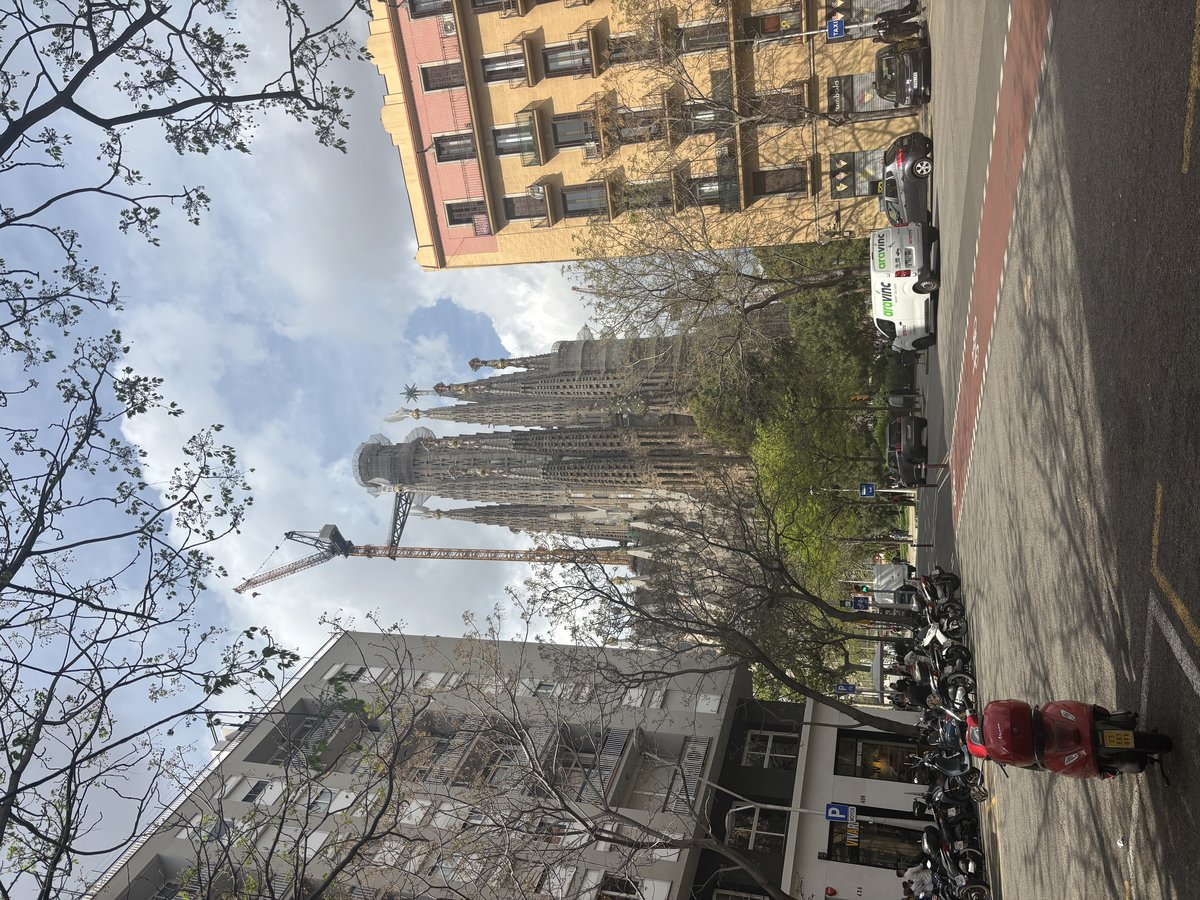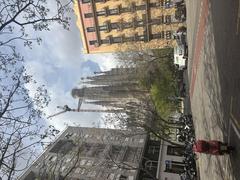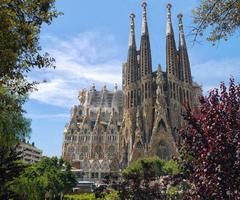
Sagrada Família Visiting Hours, Tickets, and Guide to Barcelona Historical Sites
Date: 14/06/2025
Introduction
The Basílica de la Sagrada Família is Barcelona’s most iconic landmark—an architectural marvel that intertwines religious symbolism, cultural identity, and cutting-edge innovation. Conceived in 1882 and reimagined by Antoni Gaudí from 1883, the Sagrada Família is a UNESCO World Heritage site and attracts millions of visitors each year. Gaudí’s masterpiece, still under construction after more than 140 years, stands as a testament to Barcelona’s spiritual heritage and artistic ambitions, featuring soaring towers, intricately sculpted facades, and interiors inspired by the natural world (Explorial, Rost Architects, CNN).
This guide offers a comprehensive overview, including the Sagrada Família’s history, visiting hours, ticketing details, accessibility, travel tips, and recommendations for discovering other nearby Barcelona historical sites.
Table of Contents
- History and Construction
- Symbolism and Architectural Significance
- Visiting the Sagrada Família: Essential Information
- Travel Tips, Nearby Attractions, and Highlights
- Frequently Asked Questions (FAQ)
- Conclusion and Recommendations
- References
History and Construction
Origins and Early Vision
The Sagrada Família’s origins date to 1882, when Josep Maria Bocabella initiated the project as a spiritual renewal for Barcelona, originally commissioning Francisco de Paula del Villar to design a Neo-Gothic church (Explorial, Archeyes). Del Villar resigned in 1883, after which Antoni Gaudí, then 31, became chief architect. Gaudí soon transformed the plans, envisioning a basilica that departed radically from tradition and embraced organic forms, geometric innovations, and profound Christian symbolism (CNN).
Gaudí’s Transformative Influence
Gaudí’s vision drew on Gothic and Art Nouveau styles, but infused them with biomimetic structures and deep religious meaning. He designed 18 towers to symbolize the apostles, evangelists, Virgin Mary, and Christ, and facades narrating the Nativity, Passion, and Glory (Rost Architects, Explorial, Euronews). The interior’s tree-like columns and kaleidoscopic stained glass create an atmosphere Gaudí likened to a “forest of light” (Listverse, Rost Architects).
Construction Timeline and Key Milestones
- 1882–1926: Construction began with del Villar’s crypt and apse, but Gaudí’s era marked a shift to his organic, symbolic vision. By Gaudí’s death in 1926, only a small portion was complete (Archeyes, CNN).
- 1936–1939: The Spanish Civil War severely damaged the project; much of Gaudí’s plans and models were destroyed, but work resumed postwar (Guinness World Records).
- 1940–1990: Slow progress due to financial constraints; significant acceleration occurred after the 1992 Barcelona Olympics, fueled by increased tourism (Forever Barcelona).
- 1990–Present: Modern technologies—CAD, CNC stonework, 3D printing—enabled the realization of Gaudí’s complex geometries. The interior was consecrated in 2010, and major towers have been completed in recent years (Archeyes, CNN, Guinness World Records, Sagrada Familia 2026).
- 2025–2026: Completion of the central Jesus Christ tower is anticipated to coincide with the centenary of Gaudí’s death, making it Europe’s tallest religious structure (Guinness World Records, Sagrada Familia 2026).
Symbolism and Architectural Significance
Every element of the Sagrada Família has symbolic meaning. The three facades—Nativity (joyful and ornate), Passion (austere and dramatic), and Glory (still under construction, representing salvation)—tell Christ’s story in stone (Euronews). The 18 towers honor key biblical figures. Inside, columns branch like trees, supporting parabolic vaults and flooding the nave with rainbow-hued light (Rost Architects).
Gaudí’s use of geometry—hyperboloids, helicoids, ruled surfaces—ensures both structural stability and visual harmony, while the architecture’s symbolic and spiritual depth has inspired generations of artists and architects (architecturelab.net). The basilica’s ongoing construction is itself symbolic of perseverance, faith, and innovation.
Visiting the Sagrada Família: Essential Information
Visiting Hours and Seasonal Variations
- High season (April to September): 9:00 AM–8:00 PM
- Low season (October to March): 9:00 AM–6:00 PM
- Holidays (Dec 25/26, Jan 1/6): 9:00 AM–2:00 PM
- Always check the official website for the latest updates, as hours may change for special events (barcelona.com).
Tickets: Types, Prices, and Booking Tips
- General Admission: ~€26 (includes audio guide)
- Tower Access: ~€36 (must be booked online in advance)
- Guided Tours: Available in several languages; offer in-depth exploration and priority entry
- Discounts: For children under 11, students, seniors, and persons with disabilities; Sunday Mass at 9:00 AM in the crypt is free but does not permit sightseeing (myprettytravels.com, sagradafamilia.org)
- Booking Advice: Buy tickets online in advance, as time slots sell out quickly, especially in peak season. Entry is strictly timed and non-refundable (skiptheline.tickets, thetourguy.com).
Accessibility
- Fully wheelchair accessible, with ramps and elevators
- Tower access is by stairs only and not suitable for visitors with mobility issues
- Adapted audio guides and information materials are available (thetourguy.com)
Duration of Visit
- Allow 2–3 hours to fully explore the basilica, museum, and towers
- Guided tours typically last 1.5–2 hours; allow extra time for security checks (myprettytravels.com)
Dress Code and Etiquette
- Modest attire is required: cover shoulders and knees
- Photography allowed without flash; be respectful during services (myprettytravels.com)
Security and Entry
- Airport-style security screening; large bags prohibited
- Entry via Carrer de la Marina; ticket office available for on-site purchases (visitarsagradafamilia.com)
Facilities
- Restrooms inside; no cloakroom—travel light
- Gift shop and museum on-site (thegeographicalcure.com)
Travel Tips, Nearby Attractions, and Highlights
- Best Times: Early morning (9:00 AM) and late afternoon (after 5:00 PM) offer fewer crowds and the best light for photography (thebettervacation.com)
- Metro: L2 and L5 (Sagrada Família station); buses 19, 33, 34, D50, H10, B24 (skiptheline.tickets)
- Nearby Attractions: Hospital de Sant Pau, Park Güell, Casa Milà, and other Gaudí landmarks
- Photographic Tips: Nativity Facade in morning light; Passion Facade at sunset; interior stained glass in late afternoon
- Special Experiences: Guided tours, tower visits (by special ticket), evening illuminations (select nights)
Frequently Asked Questions (FAQ)
Q: What are the Sagrada Família visiting hours?
A: Generally 9:00 AM–8:00 PM (high season), 9:00 AM–6:00 PM (low season), and 9:00 AM–2:00 PM on holidays. Check the official website for updates.
Q: How do I buy tickets?
A: Book online in advance for your preferred time slot at the official website. On-site purchase is possible but not recommended during busy periods.
Q: Is the Sagrada Família wheelchair accessible?
A: Yes, except for tower access, which is by stairs only.
Q: Are there guided tours?
A: Yes, in multiple languages. Also available: audio guides and thematic tours.
Q: Can I enter for free?
A: Only by attending Sunday Mass at 9:00 AM in the crypt (no sightseeing or photography).
Q: How long should I plan for a visit?
A: 2–3 hours, including museum and tower access.
Conclusion and Recommendations
The Sagrada Família is a living monument—an ever-evolving dialogue between tradition and innovation, faith and artistry. Its ongoing construction, anticipated to culminate in 2026 with the completion of the Jesus Christ tower, will make it the tallest religious building in Europe (Guinness World Records, Sagrada Familia 2026).
Plan your visit by booking tickets in advance, checking official hours, and arriving early or late in the day for the best experience. Explore nearby Barcelona historical sites to enrich your understanding of the city’s architectural heritage. For more travel guides, download the Audiala app and follow us on social media for updates and tips.
References
- Sagrada Família Official Website
- Explorial – Sagrada Família
- Rost Architects – The Story of Sagrada Família
- CNN – Sagrada Família Completion
- Guinness World Records – Sagrada Família
- Sagrada Familia 2026 – Construction Timeline
- Archeyes – Sagrada Família
- Euronews – Sagrada Família Facades
- Forever Barcelona – Sagrada Família Construction
- Set Your Tour Guide – Sagrada Família
- World History Journal – Sagrada Família
- Barcelona City Guide – Sagrada Família
- My Pretty Travels – Tickets and Hours
- The Better Vacation – Best Time to Visit
- The Geographical Cure – Sagrada Família Guide
- Visit Sagrada Familia – Practical Info
- Architecture Lab – Sagrada Família
- Sagrada Família Barcelona – History
- City Sightseeing – Sagrada Família































































